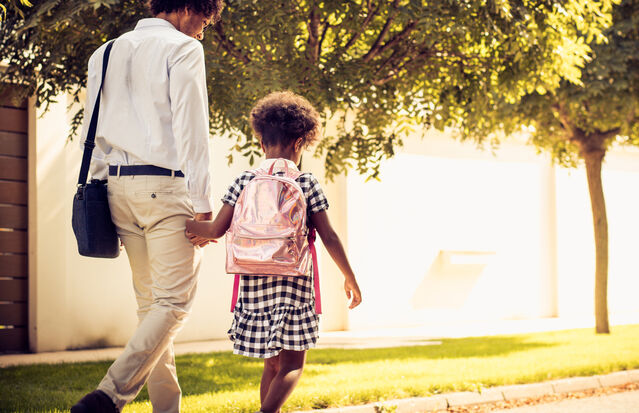Anxiety
A Back-to-School Mindset
Kids are trying to recover, and they need our help.
Posted September 5, 2022 Reviewed by Ekua Hagan
Key points
- Children are shouldering a great deal of stress as they return to school.
- Stress, in excessive amounts, interferes with performance and learning.
- Parents and teachers can modulate stress with empathy and understanding.
- Micro-healing can happen when teachers and parents temporarily set aside the agenda and address the stress a child is feeling in the moment.

Recently, somewhere deep in the universe that is Twitter, I read a post that captured for me the essence of what the back-to-school conversation for this year needs to be. A child says: “School is hard, I’m scared!” Their parent replies: “But you’re good at hard things.” The child replies: “No, I’m good at medium things.”
Out of the mouths of babes.
Truly, “hard” is in the eyes of the beholder. We wouldn’t want someone else to tell us what is or should be not hard for us, and kids are no different. Not acknowledging someone else’s struggle makes things harder, sometimes a whole lot harder. But on the other hand, simply understanding and trusting that when someone says, “This is too hard,” it is too hard in that moment—that can very much start to make things easier.
Medium Hard Challenges Are the Sweet Spot for Performance
We’ve long known—at least since the classic 1908 study when psychologists Yerkes and Dodson identified the robust relationship between stress and learning—that human beings as a species are best at “medium” challenges, not ones that are too hard (or too easy, but this hardly applies in 2022).
So here we are: back to school in 2022. All the strain, fears, grief, pressures, and isolation of the last few years have placed kids at a difficult starting point. We don’t like to think about that. I know I don’t.
But we have to, because it’s only if we can keep this disconcerting reality squarely in mind that we can actually help our kids recover from those strains—or start to—and be in the best possible mindset and physical state for learning. If, instead, we don’t do the hard thing and look at that reality and imagine that this year is somehow business as usual, not only will kids struggle, but when they do struggle—too tired to focus, to do their “best," to push themselves—they will turn the blame on themselves and think something is wrong with them. They will feel more worried, anxious, and bad about themselves. This is on top of the ongoing spike in anxiety and depression in our kids that began before the pandemic.
And recently, in the ongoing pandemic, the American Academy of Child and Adolescent Psychiatry called mental health for children a “national emergency” and a panel called for ongoing screening for anxiety for all children 8-18.
We adults can make all the difference for our kids. Our understanding and empathy. Our capacity to slow down and center protects our kids from the adverse effects of stress.
While we want to encourage our kids to achieve and challenge themselves, and especially now as parents shoulder the worry of catching up on educational gaps from the pandemic—not to mention the other worries that parents and kids are carrying—we need to remember: If things are too hard, they are too hard.
It won’t work to pressure, push, or demand. Kids will simply not be able to learn and do their best. Intrusive thoughts like: “I have to do well or else!" "I have to catch up!" "I’m behind!" "I need to do well for college!" "What’s wrong with me that I can’t do this?” will be so overpowering that our kids won’t be able to hear themselves think or let in new information when they need it on a test.
“But, this counts!” kids will say in our achievement-focused culture whether in 1st grade or college. “But this counts!” Parents will say as those stewarding our kids through that same culture. Yes, “this counts,” but our kids count more.
Of course, like that parent on Twitter, we want to encourage our kids to not back away and feel helpless in the face of challenge. Good, good instinct. But with one big caveat: We can’t just superimpose our sense of what is or should be hard, or not, on our kids.
Especially not now.
What is going on in children’s minds when they say, “I can’t, this is too hard!” or they show that sentiment by storming off, shutting down, or being disrespectful? They are trying to tell us in so many words that their nervous system is in overload/threat mode. What they are trying to manage—all the expectations, responsibilities, fears—the schedule, the work!—are tipping the scales in that moment. In that spiral of adrenaline and fear, we can imagine that things like focusing, learning, performing, winding down to sleep, being polite!—all those functions are impaired or stalled.
But there is a fork in the road.
Let Go of the Big Agenda Temporarily and Take Care of the Moment
If we can see through the overwhelm, the anger, or tears, and with our X-ray vision trust our kids and see this as a “too hard moment” then we can respond in a way that almost instantly makes it easier for them (and us!). The magic is that by acknowledging that and dropping our agenda temporarily, just for a moment, and connecting, whether it is getting our kids to do their homework, get to bed, clean their room, rush, rush, rush—the moment will become easier.
Natural enough to trust our kids, and strangely unnatural when we have an agenda in mind. Isn’t it? I have to work on this all the time—but the dish isn’t in the dishwasher! But we can just trust our kids, empathize when they are overwhelmed, and say, “it’s OK.” “We have time.” “Let’s take a minute.” “This can wait.” Or, “tell me whatever you’re feeling right now.” Do you forget about the dish, the homework, or the presentation? No, no, and no. But that comes after the emotional reset, not before.
Keeping the focus on how our children are doing on the inside—rather than on how they are “performing” on the outside—is how we ensure that they have the conditions they need for them to recover. Given the reality of the world that is today, kids will be best prepared for the future out there if they can get what they need to heal in this moment.
Healing in Split-Second Doses: Focus on Presence of the Child in Front of You
With everything that’s going on now, we may wonder, is there really time for healing? Yes. All it takes is seconds, briefly dropping your agenda throughout the year, and connecting with your children in the moments of what they are feeling, rather than racing ahead with the agenda of what needs to be done. (That can come a few seconds later.) First things first.
This reminds me of the wisdom of one of my favorite therapists, the late Dr. Dan Wile, a master at turning tension and conflict between two people into connection. His simple, but powerful guideline: “Solve the moment, not the problem,” is my mantra for this time. In the moment, your child needs to know they are OK and you love them. That’s one thing that parents are uniquely qualified to do.
Out of that reset, feeling understood and heard, kids can step out with less stress, and feel more settled. That is how we keep moving the needle down from too hard, to medium. And it’s a twofer. When kids feel better, we feel better. There is a cascade of calming, slowing and settling nervous systems. All are able to function in their optimal mode. Now doesn’t that sound better?
There is a lot weighing on our kids. Us, too. Our job is to not pretend that this isn’t the case. We, each of us, can be the supportive parent for the child in front of us. This buffer, invaluable at any time, is especially so in these complex and vulnerable times.
Slowing down and taking a deep breath here, I’m sending everyone good wishes for the new school year!
Dr. C




